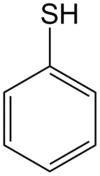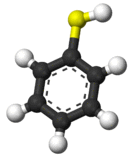| | |||
| Names | |||
|---|---|---|---|
| Preferred IUPAC name Benzenethiol[1] | |||
Other names
| |||
| Identifiers | |||
3D model (JSmol) | |||
| ChEBI | |||
| ChEMBL | |||
| ChemSpider | |||
| ECHA InfoCard | 100.003.306 | ||
PubChem CID | |||
| RTECS number |
| ||
| UNII | |||
CompTox Dashboard (EPA) | |||
| |||
SMILES
| |||
| Properties | |||
Chemical formula | C6H6S | ||
| Molar mass | 110.17 g·mol−1 | ||
| Appearance | Colorless liquid | ||
| Odor | Unpleasant, pungent | ||
| Density | 1.0766 g/mL | ||
| Melting point | −15 °C (5 °F; 258 K) | ||
| Boiling point | 169 °C (336 °F; 442 K) | ||
| 0.08%[2] | |||
| Solubility | Most organic solvents; aqueous base | ||
| Vapor pressure | 1 mmHg (18°C)[2] | ||
| Acidity (pKa) | |||
| -70.8·10−6 cm3/mol | |||
| Hazards | |||
| Main hazards | Toxic | ||
| R-phrases (outdated) | R10 R24/25 R26 R41 | ||
| S-phrases (outdated) | S23 S26 S28 S36/37/39 S45 | ||
| NFPA 704 (fire diamond) | |||
| Flash point | 56 °C; 132 °F; 329 K[2] | ||
| NIOSH (US health exposure limits): | |||
PEL (Permissible) | none[2] | ||
REL (Recommended) | C 0.1 ppm (0.5 mg/m3) [15-minute][2] | ||
IDLH (Immediate danger) | N.D.[2] | ||
| Related compounds | |||
Related thiols | 1,2-Benzenedithiol Benzenemethanethiol | ||
Related compounds | Phenol Benzeneselenol Diphenyl disulfide | ||
Except where otherwise noted, data are given for materials in their standard state (at 25 °C [77 °F], 100 kPa). | |||
Thiophenol is an organosulfur compound with the formula C6H5SH, sometimes abbreviated as PhSH. This foul-smelling colorless liquid is the simplest aromatic thiol. The chemical structures of thiophenol and its derivatives are analogous to phenols except the oxygen atom in the hydroxyl group (-OH) bonded to the aromatic ring is replaced by a sulfur atom. The prefix thio- implies a sulfur-containing compound and when used before a root word name for a compound which would normally contain an oxygen atom, in the case of 'thiol' that the alcohol oxygen atom is replaced by a sulfur atom.
Thiophenols also describes a class of compounds formally derived from thiophenol itself. All have a sulfhydryl group (-SH) covalently bonded to an aromatic ring. The organosulfur ligand in the medicine thiomersal is a thiophenol.
Synthesis
There are several methods of synthesis for thiophenol and related compounds, although thiophenol itself is usually purchased for laboratory operations. Methods are the reduction of benzenesulfonyl chloride with zinc.[5] and the action of elemental sulfur on phenyl magnesium halide or phenyllithium followed by acidification.
Via the Newman–Kwart rearrangement, phenols (1) can be converted to the thiophenols (5) by conversion to the O-aryl dialkylthiocarbamates (3), followed by heating to give the isomeric S-aryl derivative (4).[6]
In the Leuckart thiophenol reaction, the starting material is an aniline through the diazonium salt (ArN2X) and the xanthate (ArS(C=S)OR).[7][8] Alternatively, sodium sulfide and triazene can react in organic solutions and yield thiophenols.[9]
Thiophenol can be manufactured from chlorobenzene and hydrogen sulfide over alumina at 700 to 1,300 °F (371 to 704 °C). The disulfide is the primary byproduct.[10] The reaction medium is corrosive and requires ceramic or similar reactor lining. Aryl iodides and sulfur in certain conditions may also produce thiophenols.[11]
Applications
Thiophenols are used in the production of pharmaceuticals including of sulfonamides. The antifungal agents butoconazole merthiolate are derivatives of thiophenols.[9]
Properties and reactions
Acidity
Thiophenol has appreciably greater acidity than does phenol, as is shown by their pKa values (6.62 for thiophenol and 9.95 for phenol). A similar pattern is seen for H2S versus H2O, and all thiols versus the corresponding alcohols. Treatment of PhSH with strong base such as sodium hydroxide (NaOH) or sodium metal affords the salt sodium thiophenolate (PhSNa).
Alkylation
The thiophenolate is highly nucleophilic, which translates to a high rate of alkylation.[12] Thus, treatment of C6H5SH with methyl iodide in the presence of a base gives methyl phenyl sulfide, C6H5SCH3, a thioether often referred to as thioanisole. Such reactions are fairly irreversible. C6H5SH also adds to α,β-unsaturated carbonyls via Michael addition.
Oxidation
Thiophenols, especially in the presence of base are easily oxidized to diphenyl disulfide:
- 4 C6H5SH + O2 → 2 C6H5S-SC6H5 + 2 H2O
The disulfide can be reduced back the thiol using sodium borohydride followed by acidification. This redox reaction is also exploited in the use of C6H5SH as a source of H atoms.
Chlorination
Phenylsulfenyl chloride, a blood-red liquid (b.p. 41–42 °C, 1.5 mm Hg), can be prepared by the reaction of thiophenol with chlorine (Cl2).[13]
Coordination to metals
Metal cations form thiophenolates, some of which are polymeric. One example is "C6H5SCu," obtained by treating copper(I) chloride with thiophenol.[14]
Safety
The US National Institute for Occupational Safety and Health has established a recommended exposure limit at a ceiling of 0.1 ppm (0.5 mg m−3), and exposures not greater than 15 minutes.[15]
References
- ^ "Front Matter". Nomenclature of Organic Chemistry : IUPAC Recommendations and Preferred Names 2013 (Blue Book). Cambridge: The Royal Society of Chemistry. 2014. pp. P001–P004. doi:10.1039/9781849733069-FP001. ISBN 978-0-85404-182-4.
- ^ a b c d e f NIOSH Pocket Guide to Chemical Hazards. "#0050". National Institute for Occupational Safety and Health (NIOSH).
- ^ Cox, Brian G. Acids and Bases: Solvent Effects on Acid-base Strength. 1st ed. Oxford, UK: Oxford UP, 2013.
- ^ Bordwell, Frederick G.; Hughes, David L. (1982). "Thiol acidities and thiolate ion reactivities toward butyl chloride in dimethyl sulfoxide solution. The question of curvature in Broensted plots". The Journal of Organic Chemistry. 47 (17): 3224–3232. doi:10.1021/jo00138a005.
- ^ Adams, R.; C. S. Marvel, C. S. "Thiophenol". Organic Syntheses.; Collective Volume, 1, p. 504.
- ^ Melvin S. Newman and Frederick W. Hetzel (1971). "Thiophenols from Phenols: 2-Naphthalenethiol". Organic Syntheses. 51: 139. doi:10.15227/orgsyn.051.0139.
- ^ Leuckart, J. prakt. Chem., [2] 41, 189 (1890).
- ^ Tarbell, D. S.; Fukushima, D. K. (1947). "m-Thiocresol". Organic Syntheses. 27: 81. doi:10.15227/orgsyn.027.0081.; Collective Volume, 3, p. 809
- ^ a b Kazem-Rostami, Masoud; Khazaei, Ardeshir; Moosavi-Zare, Ahmad; Bayat, Mohammad; Saednia, Shahnaz (2012). "One-pot synthesis of thiophenols". Synlett. 23 (13): 1893–1896. doi:10.1055/s-0032-1316557.
- ^ US Patent 2,490,257, Duncan J. Crowley & Alvin L Kosak, "Mono- and Polyalkyl Mono- and Polynuclear Mercaptans", issued 1949-12-06, assigned to Socony-Vacuum Oil Co.
- ^ Jiang, Y.; Qin, Y.; Xie, S.; Zhang, X.; Dong, J.; Ma, D., A (2009). "General and Efficient Approach to Aryl Thiols: CuI-Catalyzed Coupling of Aryl Iodides with Sulfur and Subsequent Reduction". Organic Letters. 22 (1): 52–56. doi:10.1021/acs.orglett.9b03866. PMID 31833778.
- ^ Campopiano, O. (2004). "Thiophenol". Encyclopedia of Reagents for Organic Synthesis. New York: John Wiley & Sons. doi:10.1002/047084289X. ISBN 9780471936237..
- ^ Barrett, A. G. M.; Dhanak, D.; Graboski, G. G.; Taylor, S. J. (1993). "(Phenylthio)nitromethane". Organic Syntheses.; Collective Volume, 8, p. 550
- ^ Posner, G. H.; Whitten, C. E. "Secondary and Tertiary Alkyl Ketones from Carboxylic Acid Chlorides and Lithium Phenylthio(alkyl)cuprate Reagents: tert-Butyl Phenyl Ketone". Organic Syntheses.; Collective Volume, 6, p. 248
- ^ CDC - NIOSH Pocket Guide to Chemical Hazards
External links
- Thiophenol, Toxicology Data Network



